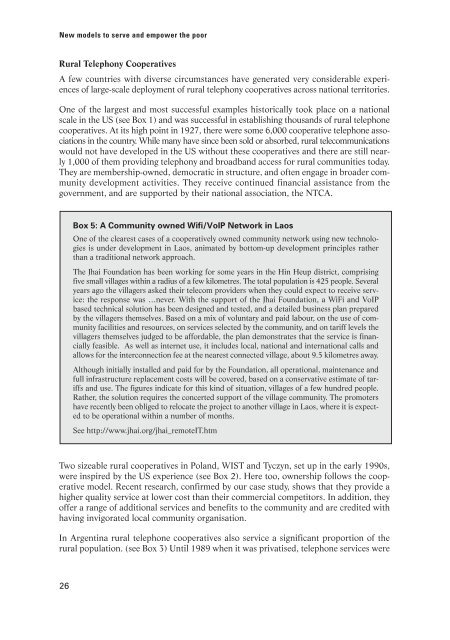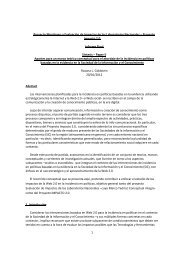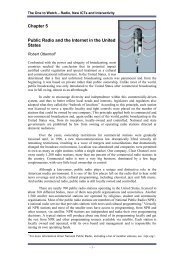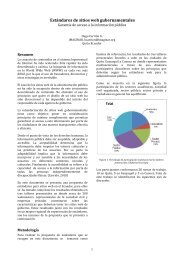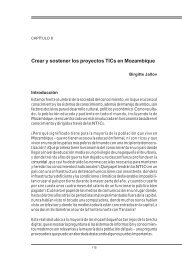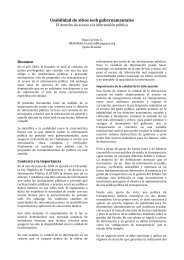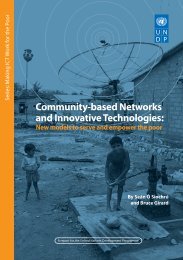Community-based Networks and Innovative Technologies: New ...
Community-based Networks and Innovative Technologies: New ...
Community-based Networks and Innovative Technologies: New ...
You also want an ePaper? Increase the reach of your titles
YUMPU automatically turns print PDFs into web optimized ePapers that Google loves.
<strong>New</strong> models to serve <strong>and</strong> empower the poorRural Telephony CooperativesA few countries with diverse circumstances have generated very considerable experiencesof large-scale deployment of rural telephony cooperatives across national territories.One of the largest <strong>and</strong> most successful examples historically took place on a nationalscale in the US (see Box 1) <strong>and</strong> was successful in establishing thous<strong>and</strong>s of rural telephonecooperatives. At its high point in 1927, there were some 6,000 cooperative telephone associationsin the country. While many have since been sold or absorbed, rural telecommunicationswould not have developed in the US without these cooperatives <strong>and</strong> there are still nearly1,000 of them providing telephony <strong>and</strong> broadb<strong>and</strong> access for rural communities today.They are membership-owned, democratic in structure, <strong>and</strong> often engage in broader communitydevelopment activities. They receive continued financial assistance from thegovernment, <strong>and</strong> are supported by their national association, the NTCA.Box 5: A <strong>Community</strong> owned Wifi/VoIP Network in LaosOne of the clearest cases of a cooperatively owned community network using new technologiesis under development in Laos, animated by bottom-up development principles ratherthan a traditional network approach.The Jhai Foundation has been working for some years in the Hin Heup district, comprisingfive small villages within a radius of a few kilometres. The total population is 425 people. Severalyears ago the villagers asked their telecom providers when they could expect to receive service:the response was …never. With the support of the Jhai Foundation, a WiFi <strong>and</strong> VoIP<strong>based</strong> technical solution has been designed <strong>and</strong> tested, <strong>and</strong> a detailed business plan preparedby the villagers themselves. Based on a mix of voluntary <strong>and</strong> paid labour, on the use of communityfacilities <strong>and</strong> resources, on services selected by the community, <strong>and</strong> on tariff levels thevillagers themselves judged to be affordable, the plan demonstrates that the service is financiallyfeasible. As well as internet use, it includes local, national <strong>and</strong> international calls <strong>and</strong>allows for the interconnection fee at the nearest connected village, about 9.5 kilometres away.Although initially installed <strong>and</strong> paid for by the Foundation, all operational, maintenance <strong>and</strong>full infrastructure replacement costs will be covered, <strong>based</strong> on a conservative estimate of tariffs<strong>and</strong> use. The figures indicate for this kind of situation, villages of a few hundred people.Rather, the solution requires the concerted support of the village community. The promotershave recently been obliged to relocate the project to another village in Laos, where it is expectedto be operational within a number of months.See http://www.jhai.org/jhai_remoteIT.htmTwo sizeable rural cooperatives in Pol<strong>and</strong>, WIST <strong>and</strong> Tyczyn, set up in the early 1990s,were inspired by the US experience (see Box 2). Here too, ownership follows the cooperativemodel. Recent research, confirmed by our case study, shows that they provide ahigher quality service at lower cost than their commercial competitors. In addition, theyoffer a range of additional services <strong>and</strong> benefits to the community <strong>and</strong> are credited withhaving invigorated local community organisation.In Argentina rural telephone cooperatives also service a significant proportion of therural population. (see Box 3) Until 1989 when it was privatised, telephone services were26


